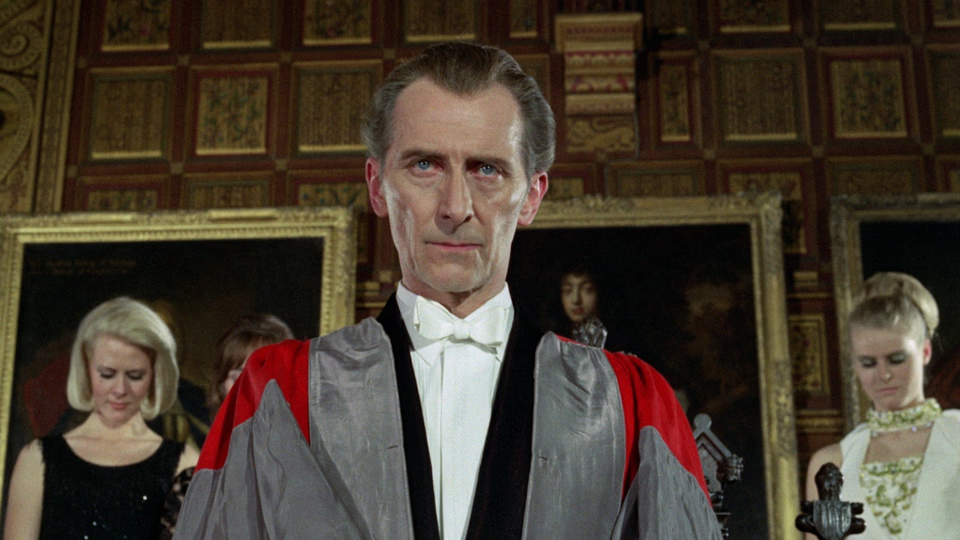Blood Suckers

What to make of Blood Suckers? A production that ran out of money during filming and was assembled later by the producers, prompting director Robert Hartford-Davis to remove his name from the finished product.1 The performances range from awkward to moving, the editing careens between amateurish and inspired, and direction between tepid and dynamic. It is a film of highs and lows: the guffaws almost equal the thrills—but at times, it shows flashes of brilliance.
The plot concerns a young Oxford Scholar, Richard, played by Patrick Mower, who has gotten mixed up with a bad crowd in Mykonos. The Foreign Office dispatches an agent, Tony, to retrieve Richard to avoid a scandal. In Greece, Tony partners with the local military attaché, played by Patrick Macnee. In trying to locate Richard, they discover he may be under the influence of a young woman who may be some kind of vampire.
This plot resembles 1968’s The Devil Rides Out, which also starred Mower as a young man who’d fallen in with a bad crowd, but where that film played as a straight supernatural adventure, Blood Suckers weaves in an interesting sexual angle, positing vampirism as a form of sexual deviance.
The sexual subtext, both hetero and homo, permeates the film. Many scenes of heated debate unfold in a manner where you half expect the debaters to suddenly kiss. More often than not, this manufactured tension elicits guffaws, but framed against the film’s larger themes, it intrigues. When one character asserts he’s “not homosexual,” the film expects us to take it as true. But that doesn’t mean he can’t be bisexual.
But the plot and subtext don’t convey the rollercoaster viewing experience. Consider the opening. After a lengthy bit of Dragnet-style voice-over narration from Tony that introduces the plot and all the characters, Tony arrives at Oxford where he meets Penelope, Richard’s “informal” fiancée, her father, the Oxford Provost, played by Peter Cushing, and Bob, Richard’s star pupil and close friend.
The group then proceeds to reiterate all the expository information we just heard in Tony’s narration. Worse still, the editing is abrupt, cutting between close-ups of each speaker before they even catch their breath, almost as if these were pickup shots without the full cast, then edited together later. Then we smash cut to a plane where Tony, Penelope, and Bob are flying to Greece.
Awful editing. And yet, a few minutes later the film shows an inventive touch, filming a drug-fueled orgy that culminates in a ritual sacrifice through a kaleidoscope lens that captures the event’s inebriated frenzy through a myriad of odd angles and creative edits.
But, lest you think the film a sexploitation outing, the rollercoaster rolls on, shifting into action/adventure. By the end of the second act, our protagonists are winding their way toward a mountain abbey. In a scene epitomizing the film’s extremes, Macnee first dodges some obvious papier-mâché boulders before slipping down a cliff. The stunt work shines here, with Macnee convincingly holding on for his life.
The fight scenes also teem with highs and lows. When Macnee runs in and jump-kicks a would-be assailant, you cheer, but when the punches and kicks whiff in the air, you cringe.
But the film finds its stride at the end. Though his role amounts to little more than an extended cameo, Cushing delivers one of his most powerful scenes in the finale, looking straight into the camera and announcing his daughter’s fate.
And then there’s the closing freeze-frame, a shot I can’t believe no vampire film has used before or cribbed since.
So what to make of Blood Suckers? It is a film of dichotomies. A low-budget effort shot on location with access to a helicopter. An often laughably inept script that still brings something new to the vampire tale. And performances that range from flat to resonant. I can’t say it’s a good movie, but I can’t dismiss it either. Perhaps, had Hartford-Davis not run out of money, he might have crafted an exploitation classic. Or maybe, it’s the inanity that gives the film its charm. If you’re a Cushing fan, and enjoyed his previous collaboration with Hartford-Davis, Corruption, you could do worse than give it a look. Just be prepared for a bumpy ride.
Notes
-
David Miller, Peter Cushing: A Life in Film (London: Titan Books, 2013), 124. ↩︎